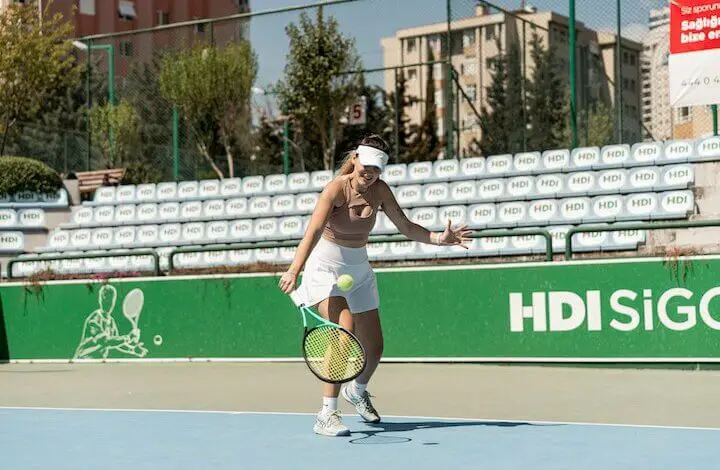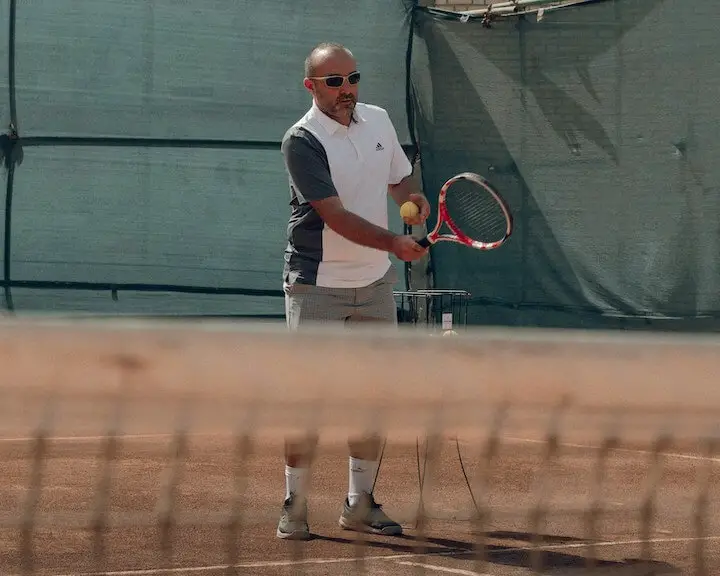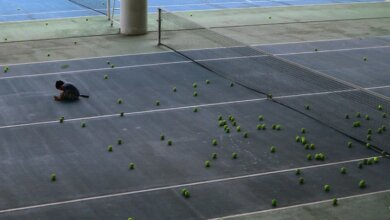
We're an affiliate
We hope you love the products we recommend! Just so you know, we may collect a share of sales or other compensation from the links on this page. Thank you if you use our links, we really appreciate it!
You ever watched a tennis match and suddenly heard someone yell “let!” — and then… nothing happens? Nobody cheers. Nobody scores. Everyone just resets and starts again. Weird, right? If you’re new to tennis or just trying to understand the game better, you’re probably wondering: what is a let in tennis? And more importantly, why does it matter?
Let me break it down like we’re just two friends talking courtside. Tennis has its own quiet language, and the word “let” is one of those terms that can feel confusing at first. But don’t worry. Once you know what it means, it starts to make total sense. And if you’re planning on playing or even just watching more matches, it helps to know why a “let” isn’t just a throwaway moment.
Table of Contents
Key Takeaways
- A let in tennis is a do-over, not a penalty.
- Most lets happen when a serve hits the net but still lands in.
- You replay the point or serve after a let.
- No one wins or loses a point from a let directly.
- Lets help keep the game fair and balanced.
- You can’t lose a point on a let.
- Professional matches use machines to call lets.
- Casual matches let players call lets themselves.
What Is a Let in Tennis?
So let’s start simple. A let in tennis is basically a do-over — but not because someone made a mistake. It’s a little reset button the game allows, usually when something unexpected or unfair happens.
Most of the time, you’ll hear “let” during a serve. Imagine this: someone serves the ball, it hits the net, but still drops nicely into the correct box. It didn’t miss. It wasn’t out. But it hit the net first. That’s a let. No point, no penalty. Just serve again.
It’s kind of like the game saying, “Hold on, that wasn’t clean. Try again.”
And that’s really what a let in tennis is about. Fairness. Clean play. A little pause to make sure everyone starts from the same place.
You could also think of a let as tennis’s way of resetting the energy. No pressure. No rush. Just a moment to regroup. It gives both players another fair chance to get the point going.

When Does a Let Happen? (Let Situations in Tennis)
There are a few situations where a let can be called. You might be surprised how many small things can trigger it:
- Serve hits the net but lands in — the most common let. You just replay the serve.
- Distraction from another court — a ball rolls onto the court mid-point? That’s a let.
- Unexpected noise — maybe someone in the crowd drops a bottle or shouts.
- Player wasn’t ready — if the returner isn’t prepared when the serve comes, it can be a let.
- Equipment failure — strings break mid-point or something else interrupts play.
Let’s say you’re on court, fully focused, and just as you go to serve, a gust of wind knocks over a chair behind you. Your opponent turns their head. Serve goes in, but they’re distracted. That’s a let. Replay the point.
Sometimes it feels annoying, especially if the rally was going well. But remember, it protects the flow of the game. A let ensures that no point is won or lost due to weird luck or surprise distractions.
Also Read: How to Volley Like a Pro: Simple Steps That Actually Work
What Happens After a Let in Tennis?
So you hear “let.” What now?
Simple. You do it again. That’s it.
If it was a let on your first serve, you get to serve again. If it was a let on your second serve, good news — you still get another chance.
The point is completely wiped clean like it never happened. No advantage. No penalty. Just a fresh start. That’s what a let in tennis is meant to do. It takes away the noise, the fluke, the chance.
It’s a little reminder from the sport: “Let’s keep this clean.”
There’s even something relaxing about it. You feel the tension rise when a serve hits the net, but then someone calmly calls, “Let.” And just like that, you breathe out. Start fresh.
Can You Lose a Point on a Let?
Nope. A let never costs you a point directly. That’s the beauty of it.
But it can shake things up a bit. If you hit a perfect serve that clips the net and lands in, you might feel frustrated when it gets called a let. Or maybe you were just about to win a rally when someone shouted from the stands, and now you have to replay it.
That doesn’t seem fair, right? But that’s the thing about tennis. It wants both players to have a fair shot. Even if that means replaying a point that looked like yours.
So while you can’t lose a point from a let, you can definitely lose momentum. And in tennis, momentum is everything. It’s the difference between staying calm or getting rattled.
Sometimes players try to use a let to reset themselves mentally. Maybe they weren’t ready. Maybe they needed a second to clear their head. It happens. And it’s allowed.
What Does a Let Sound Like on the Court?
If you ever attend a live match or even watch closely on TV, you’ll start to notice it. The umpire usually says it with a calm, firm tone: “Let.”
No fuss. No emotion.
Sometimes it’s the players who stop and call it themselves, especially in casual matches. You’ll hear someone say “let, let!” and everyone resets. In those moments, it feels like the rhythm of the match just breathes out for a second.
Then, right back in.
Even during practice, you might hear it often. Players will stop mid-serve and calmly restart. There’s no shame in it. Just a small, shared understanding.
Let vs Fault vs Ace: Clearing Up the Confusion
Let’s be real — if you’re just starting out, these words can blur together. But they mean very different things:
- Let: The serve or point is stopped and replayed. No penalty.
- Fault: The serve was bad (hit the net and didn’t go in, went out, or wrong box).
- Ace: The serve was perfect. It landed in, and the opponent couldn’t touch it.
You might also hear “double fault” — that means the server messed up both their first and second serve. That does cost a point.
But a let? That’s the kindest of them all. It says, “That wasn’t quite right. Let’s try again.”
Why Does the Let Rule Exist in Tennis?
This is where tennis gets kind of beautiful.
The game is built on respect. You respect your opponent. Pay respect the score. You respect the silence before a serve.
A let in tennis is just another way the sport says: “We want this to be right. Let’s give it another go.”
It prevents lucky breaks, removes the weird bounce off the net. and keeps the game honest.
And honestly? That says something. In a world where people chase shortcuts, tennis steps back and says, “Nope. We do it right, or we don’t count it.”
There’s a deeper peace in that. You’re not racing to the finish. You’re flowing through each point, fully present.
Can You Call a Let Yourself?
Yes — and no.
In casual matches, absolutely. If your friend serves and it clips the net but lands in, just say “let” and go again. Nobody gets mad.
But in professional matches, it’s a bit stricter. Players don’t get to call lets. It’s up to the chair umpire or the electronic let sensors placed on the net.
And yeah, this can cause drama. Some players might think they heard a let but the machine says no. Then there’s tension, a few side-eyes, and maybe a muttered complaint. But the rule is the rule.
You can’t challenge a let call. Once it’s called, it stands.
How Often Do Lets Happen in a Match?
You might be wondering if lets are rare. Not really.
In fact, if you watch a full match, especially at the pro level, you’ll likely hear “let” several times. It happens more often during high-speed serves. When someone smashes a serve at 120 mph, even a light touch on the net cord can cause a let.
It’s part of the rhythm. You might hear three or four lets in a single game. And that’s okay.
Check Out: Ultimate String Tension Guide for Beginners: Find Your Perfect Setup
What Is a Let in Tennis Doubles Matches?
The let rule works the same in doubles. If the serve hits the net and lands in, it’s still a let.
The only difference is that in doubles, things move faster. There are more moving parts. So distractions or equipment issues might be a little more common.
Still, the rule holds. Call a let, replay the serve or point. Simple.

Conclusion
So now you know. What is a let in tennis? It’s not a trick, a penalty, or a secret code. It’s a small, fair pause in a fast-moving game. A quiet moment to start fresh.
Sometimes the ball hits the net. Sometimes the world gets in the way. And sometimes, you just need a clean slate.
A let reminds you that not every interruption is a setback. Sometimes, it’s just a breath. And in tennis, that breath might be all you need to serve again, stronger and smarter.
So the next time you hear someone call a let, smile. Now you know. And now you’re part of that rhythm too.
Frequently Asked Questions
What is a let in tennis?
A let is when a point or serve is stopped and replayed, usually due to a net touch or external interruption. No penalty, no point change.
How is a let different from a fault?
A fault is a bad serve (out, net, wrong box). A let is a clean reset. Faults cost you chances; lets don’t.
Can you challenge a let call in tennis?
No, let calls can’t be challenged. In pro matches, they’re decided by the umpire or net sensors.
Do lets happen often in a match?
Not constantly, but they’re not rare. You’ll definitely hear a few in any solid game — especially on fast serves.
Is a let allowed more than once per point?
Yes, if you hit two lets in a row, you replay both. There’s no limit.
Why is it called a “let” in tennis?
Some believe it comes from the Old Saxon word “lettian,” meaning to hinder or delay.
Are there different rules for lets in junior matches?
In junior matches, coaches often teach kids to call their own lets, which builds sportsmanship.
Do lets exist outside of the serve?
Yes. If a point is interrupted mid-rally by something unexpected, a let can still be called.




